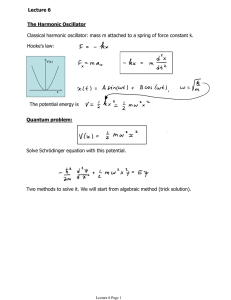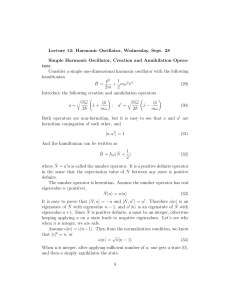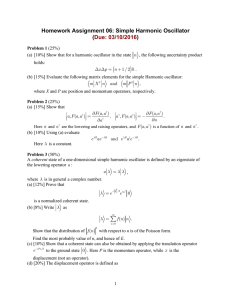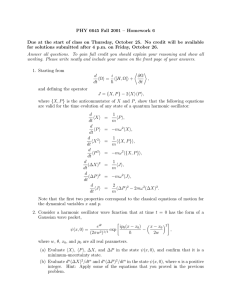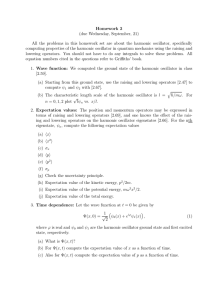Harmonic Oscillator
advertisement
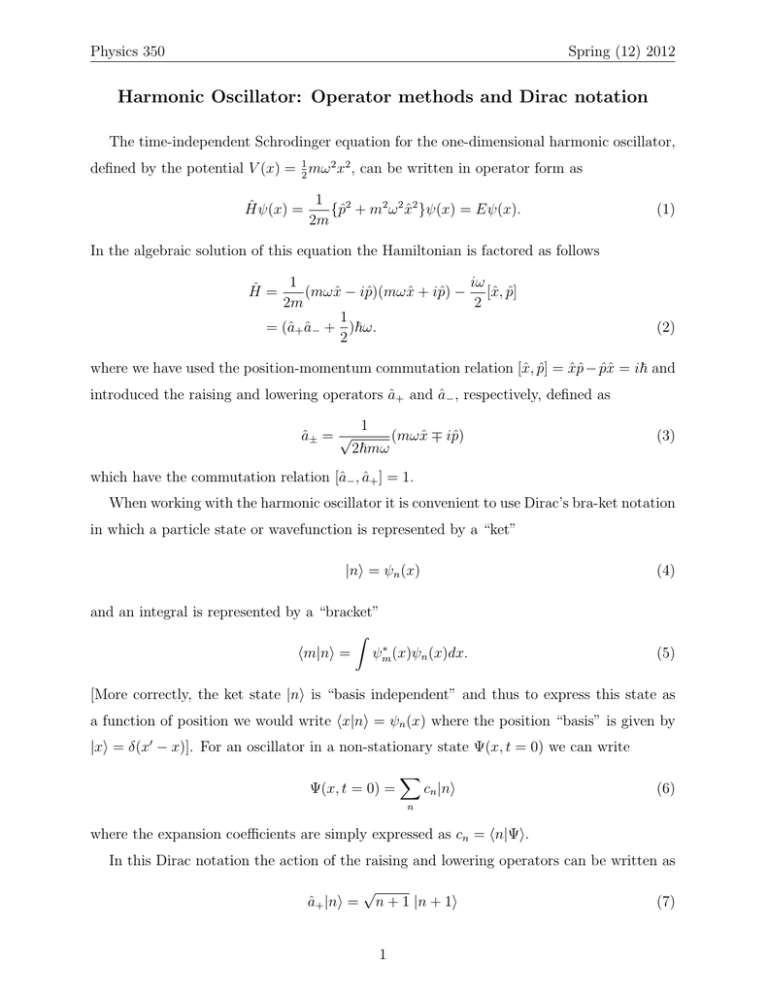
Physics 350
Spring (12) 2012
Harmonic Oscillator: Operator methods and Dirac notation
The time-independent Schrodinger equation for the one-dimensional harmonic oscillator,
defined by the potential V (x) = 12 mω 2 x2 , can be written in operator form as
Ĥψ(x) =
1
{p̂2 + m2 ω 2 x̂2 }ψ(x) = Eψ(x).
2m
(1)
In the algebraic solution of this equation the Hamiltonian is factored as follows
iω
1
(mωx̂ − ip̂)(mωx̂ + ip̂) − [x̂, p̂]
2m
2
1
= (â+ â− + )~ω.
2
Ĥ =
(2)
where we have used the position-momentum commutation relation [x̂, p̂] = x̂p̂ − p̂x̂ = i~ and
introduced the raising and lowering operators â+ and â− , respectively, defined as
â± = √
1
(mωx̂ ∓ ip̂)
2~mω
(3)
which have the commutation relation [â− , â+ ] = 1.
When working with the harmonic oscillator it is convenient to use Dirac’s bra-ket notation
in which a particle state or wavefunction is represented by a “ket”
|ni = ψn (x)
(4)
and an integral is represented by a “bracket”
Z
∗
hm|ni = ψm
(x)ψn (x)dx.
(5)
[More correctly, the ket state |ni is “basis independent” and thus to express this state as
a function of position we would write hx|ni = ψn (x) where the position “basis” is given by
|xi = δ(x0 − x)]. For an oscillator in a non-stationary state Ψ(x, t = 0) we can write
Ψ(x, t = 0) =
X
cn |ni
(6)
n
where the expansion coefficients are simply expressed as cn = hn|Ψi.
In this Dirac notation the action of the raising and lowering operators can be written as
â+ |ni =
√
n + 1 |n + 1i
1
(7)
Physics 350
Spring (12) 2012
and
â− |ni =
√
n |n − 1i
(8)
where the nth stationary state can be generated via
1
|ni = √ (â+ )n |0i
n!
(9)
and the ground state is given explicitly by
|0i = (β/π)1/4 e−βx
2 /2
(10)
with β = mω/~.
Exercise: Use Eqs. (2), (6), and (7) to show that Ĥ |ni = (n + 21 )~ω |ni
This operator formalism provides an elegant means to compute expectation values of
dynamical variables. To see this we first express the position and momentum operators in
terms of the raising and lowering operators:
r
~
x̂ =
(â+ + â− )
2mω
and
r
p̂ = i
~mω
(â+ − â− ).
2
(11)
(12)
Thus, for example, the expectation value of x2 can be computed as
hx2 in = hn|x̂2 |ni
~
hn|â+ â+ + â+ â− + â− â+ + â− â− |ni
2mω
√
p
p
~ p
=
(n + 2)(n + 1) hn|n + 2i + n2 hn|ni + (n + 1)2 hn|ni + n(n − 1) hn|n − 2i
2mω
~
=
(2n + 1)
(13)
2mω
=
where we use the convention hn|x̂2 |ni = hn|x̂2 ni and we have used the orthogonality relation
hn|mi = δn,m to evaluate the brackets.
Exercise: Use operator methods to show that the expectation value of the kinetic energy is
half the total energy, i.e., hKin = hp̂2 /2min = En /2.
2

